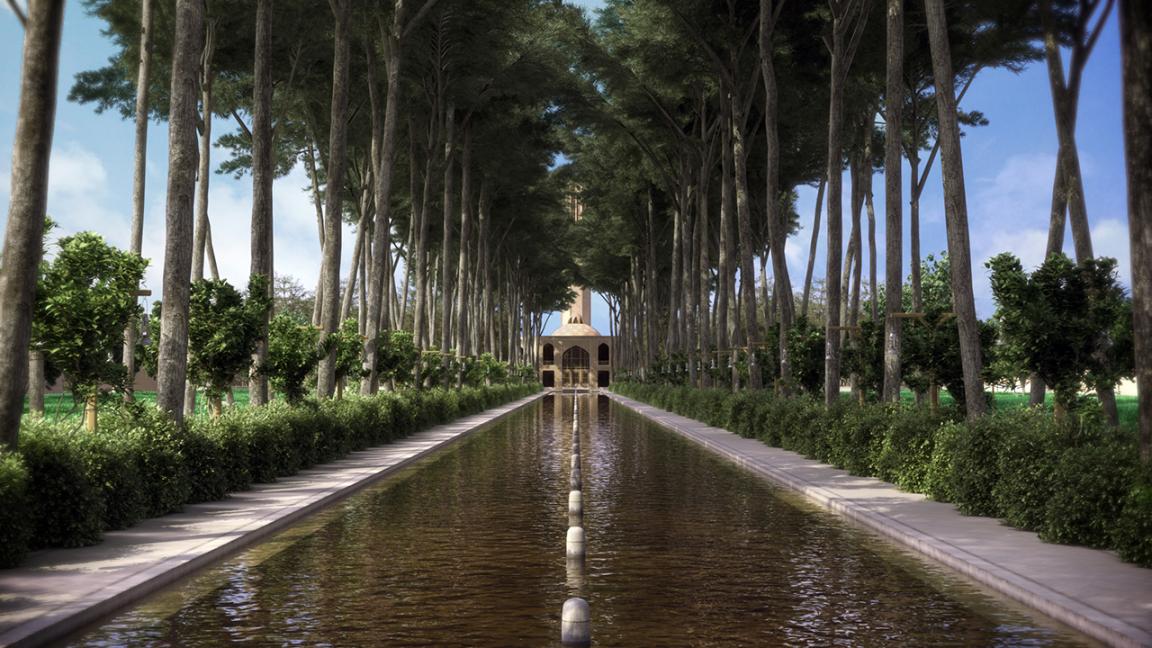One of the biggest in Iran, the Dowlatabad Garden in Yazd was built during the reign of the Zand dynasty. Iran’s tallest wind-tower is also located within the garden, according to Paygah-e-Ettelahresaniy-Baq-e-Irani.
There are 2,000 acres of open garden and buildings covering 40,000 square meters including the walled Persian gardens.
There are several different representations of traditional Iranian architecture within the garden namely the main entrance, mirrored hall, wind-tower, harem, servants quarters, kitchens, ‘ab anbars’ or drinking-water reservoirs, and stables. There are also several qanats, waterways, and ponds within the garden.
The massive historical Qanat of Dowlatabad which is more than 200 years old is created where five small qanats come together. The main source of the water was located in Mehriz.
Before reaching the qanats, the water irrigated the lands within Mehriz and put several water mills into motion. After 50 kilometers, the water reached Yazd and irrigated the hamlets across such areas as Abashahi, Khorramshah, and finally the Dowlatabad Garden.
Currently, the garden is irrigated using water from a well nearby.
The main building and wind-tower stand in the center, next to a vestibule, with three rooms at the top and on the sides. There are also two buildings, one to the left and another to the right.
The architect has craftily incorporated water into the very fabric of the design: first, water sprouts out of a marble pond underneath the wind-tower, it then finds its way into another pond in the middle of the vestibule. From the middle of the vestibule, water trickles down three streams which lead to three other ponds in three different alcoves with ‘panjdaris’.
Panjdari is a large room which is often flanked to the main halls of the house. It is most often connected to a large balcony, where five large contiguous windows provide views to the courtyard of the house.
In front of the sash windows there is ‘sineh kabki’ (literally pheasant chests) which is in fact repeated patterns on the bottom of ponds which are carved to give the illusion that there is plenty of water in the pond even when water is scarce.
Water then flows down into a clay pond and into smaller streams on either sides of the main water canal which runs all the way down to the main entrance.
In the past the water would exit into a large pool in the shape of a dodecagon right outside the garden and then enter three other pools. The water from these pools was eventually used for irrigation and agriculture.
The qanats, these hundred years old emblems of Persian ingenuity, today are blocked, and water no longer reaches the garden. To irrigate the garden and fill the ponds, water is drawn from wells. As a consequence, sadly, the garden has never regained its initial liveliness and splendor.
Marble is one of the main materials used in the garden architecture. The marble was brought from Maragheh which is rather strange since the marble from Yazd was very well known for its quality at the time.
The main buildings in the garden are: ‘biruni’ (outside or public quarters) situated on the east side, ‘andaruni’ (inside or private quarters) situated on the west side, the main entrance, as well as Iran’s highest wind-tower (33.80 meters high).
The vestibule and the wind-tower are the two most important structures in the complex, where water and air meet in the most glorious possible way.
The ceilings have been skillfully designed by Haji Ali Akbar Akhund. The sash windows have been renovated and fitted with tainted glass which has only intensified the beauty of the building.
Pines and cypress trees have been planted in the garden, along with a number of grape vines, pomegranate trees, and rose shrubs.
The skilful architecture, landscaping, and water distribution make Dowlatabad Garden one the most magnificent sightseeing attractions in Iran.


